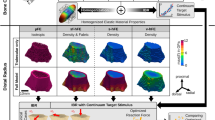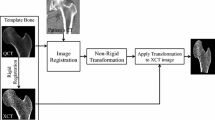Abstract
Preclinical and clinical bone strength predictions can be elucidated by understanding bone mechanics at a variety of hierarchical levels. As such, down-sampled micro-CT images are often used to make comparisons across image resolutions or used to reduce computational resources in micro finite element models (µFEMs). Therefore, the objectives of this study were to compare trabecular apparent modulus among (i) hexahedral and tetrahedral µFEMs, (ii) µFEMs generated from 32, 64, and 64 µm down-sampled from 32 µm µCT scans, and (iii) µFEMs with homogeneous and heterogeneous tissue moduli. Trabecular µFEMs were generated from scans at the three spatial resolutions taken from the glenoid vault of 14 cadaveric specimens. Simulated unconstrained compression was performed and used to calculate and compare the apparent modulus of each µFEM. It was found that models derived from high-resolution images that account for material heterogeneity are nearly equivalent whether hexahedral or tetrahedral elements are used. However, translation of stiffness from down-sampled scans are not equivalent to scans performed at the down-sampled resolution, or that account for trabecular material heterogeneity. Material heterogeneity is most representative of in vivo trabecular bone and to accurately model trabecular mechanical properties, material heterogeneity should be considered in future µFEM development.





Similar content being viewed by others
References
Bauer, J. S., I. Sidorenko, D. Mueller, T. Baum, A. S. Issever, F. Eckstein, E. J. Rummeny, T. M. Link, and C. W. Raeth. Prediction of bone strength by μcT and MDCT-based finite-element-models: how much spatial resolution is needed? Eur. J. Radiol. 83:e36–e42, 2014.
Bayraktar, H. H., E. F. Morgan, G. L. Niebur, G. E. Morris, E. K. Wong, and T. M. Keaveny. Comparison of the elastic and yield properties of human femoral trabecular and cortical bone tissue. J. Biomech. 37:27–35, 2004.
Bevill, G., and T. M. Keaveny. Trabecular bone strength predictions using finite element analysis of micro-scale images at limited spatial resolution. Bone 44:579–584, 2009.
Bourne, B. C., and M. C. H. Van Der Meulen. Finite element models predict cancellous apparent modulus when tissue modulus is scaled from specimen CT-attenuation. J. Biomech. 37:613–621, 2004.
Brennan, O., O. D. Kennedy, T. C. Lee, S. M. Rackard, and F. J. O’Brien. Biomechanical properties across trabeculae from the proximal femur of normal and ovariectomised sheep. J. Biomech. 42:498–503, 2009.
Chen, Y., E. Dall’Ara, E. Sales, K. Manda, R. Wallace, P. Pankaj, and M. Viceconti. Micro-CT based finite element models of cancellous bone predict accurately displacement once the boundary condition is well replicated: a validation study. J. Mech. Behav. Biomed. Mater. 65:644–651, 2017.
Costa, M. C., G. Tozzi, L. Cristofolini, V. Danesi, M. Viceconti, and E. Dall’Ara. Micro finite element models of the vertebral body: validation of local displacement predictions. PLoS One 12:1–18, 2017.
Cyganik, Ł., M. Binkowski, G. Kokot, T. Rusin, P. Popik, F. Bolechała, R. Nowak, Z. Wróbel, and A. John. Prediction of Young’s modulus of trabeculae in microscale using macro-scale’s relationships between bone density and mechanical properties. J. Mech. Behav. Biomed. Mater. 36:120–134, 2014.
Dall’Ara, E., M. Peña-Fernández, M. Palanca, M. Giorgi, L. Cristofolini, and G. Tozzi. Precision of digital volume correlation approaches for strain analysis in bone imaged with micro-computed tomography at different dimensional levels. Front. Mater. 4:31, 2017.
Depalle, B., R. Chapurlat, H. Walter-Le-Berre, B. Bou-Saïd, and H. Follet. Finite element dependence of stress evaluation for human trabecular bone. J. Mech. Behav. Biomed. Mater. 18:200–212, 2013.
Faieghi, M., N. K. Knowles, O. R. Tutunea-fatan, and L. M. Ferreira. Fast generation of cartesian meshes from micro-computed tomography data. Comput. Aided Des. Appl. 16:161–171, 2019.
Harrison, N. M., P. F. McDonnell, D. C. O’Mahoney, O. D. Kennedy, F. J. O’Brien, and P. E. McHugh. Heterogeneous linear elastic trabecular bone modelling using micro-CT attenuation data and experimentally measured heterogeneous tissue properties. J. Biomech. 41:2589–2596, 2008.
Helgason, B., E. Perilli, E. Schileo, and F. Taddei. Mathematical relationships between bone density and mechanical properties: a literature review. Clin. Biomech. 23:135–146, 2008.
Jaasma, M. J., H. H. Bayraktar, G. L. Niebur, and T. M. Keaveny. Biomechanical effects of intraspecimen variations in tissue modulus for trabecular bone. J. Biomech. 35:237–246, 2002.
Kim, D. G., G. T. Christopherson, X. N. Dong, D. P. Fyhrie, and Y. N. Yeni. The effect of microcomputed tomography scanning and reconstruction voxel size on the accuracy of stereological measurements in human cancellous bone. Bone 35:1375–1382, 2004.
Lu, Y. Influence of the specimen scan condition on the finite element voxel model of human vertebral cancellous bone. Comput. Methods Biomech. Biomed. Eng. Imaging Vis. 3:172–176, 2015.
Lu, Y., K. Engelke, C.-C. Glueer, M. M. Morlock, and G. Huber. The effect of in situ/in vitro threedimensional quantitative computed tomography image voxel size on the finite element model of human vertebral cancellous bone. Proc. Inst. Mech. Eng. Part H J. Eng. Med. 228:1208–1213, 2014.
Niebur, G. L., J. C. Yuen, A. C. Hsia, and T. M. Keaveny. Convergence behavior of high-resolution finite element models of trabecular bone. J. Biomech. Eng. 121:629, 1999.
Oftadeh, R., M. Perez-Viloria, J. C. Villa-Camacho, A. Vaziri, and A. Nazarian. Biomechanics and mechanobiology of trabecular bone: a review. J. Biomech. Eng. 137:10802, 2015.
Palanca, M., A. J. Bodey, M. Giorgi, M. Viceconti, D. Lacroix, L. Cristofolini, and E. Dall’Ara. Local displacement and strain uncertainties in different bone types by digital volume correlation of synchrotron microtomograms. J. Biomech. 58:27–36, 2017.
Pegg, E. C., and H. S. Gill. An open source software tool to assign the material properties of bone for ABAQUS finite element simulations. J. Biomech. 49:3116–3121, 2016.
Renders, G. A. P., L. Mulder, G. E. J. Langenbach, L. J. van Ruijven, and T. M. G. J. van Eijden. Biomechanical effect of mineral heterogeneity in trabecular bone. J. Biomech. 41:2793–2798, 2008.
Renders, G. A. P., L. Mulder, L. J. van Ruijven, G. E. J. Langenbach, and T. M. G. J. van Eijden. Mineral heterogeneity affects predictions of intratrabecular stress and strain. J. Biomech. 44:402–407, 2011.
van Rietbergen, B., H. Weinans, R. Huiskes, and A. Odgaard. A new method to determine trabecular bone elastic properties and loading using micromechanical finite-elements models. J. Biomech. 28:69–81, 1995.
van Ruijven, L. J., L. Mulder, and T. M. G. J. van Eijden. Variations in mineralization affect the stress and strain distributions in cortical and trabecular bone. J. Biomech. 40:1211–1218, 2007.
Acknowledgments
The authors would like to thank Dr. Andrew Nelson for his assistance with microCT scanning, Mohammadreza Faieghi for the voxelization code, and Shruthi Poolacherla for her assistance with data collection. Nikolas K. Knowles is supported in part by an Ontario Graduate Scholarship and by a Transdisciplinary Bone & Joint Training Award from the Collaborative Training Program in Musculoskeletal Health Research at The University of Western Ontario.
Author information
Authors and Affiliations
Corresponding author
Additional information
Associate Editor Ka-Wai Kwok oversaw the review of this article.
Rights and permissions
About this article
Cite this article
Knowles, N.K., Ip, K. & Ferreira, L.M. The Effect of Material Heterogeneity, Element Type, and Down-Sampling on Trabecular Stiffness in Micro Finite Element Models. Ann Biomed Eng 47, 615–623 (2019). https://doi.org/10.1007/s10439-018-02152-6
Received:
Accepted:
Published:
Issue Date:
DOI: https://doi.org/10.1007/s10439-018-02152-6




